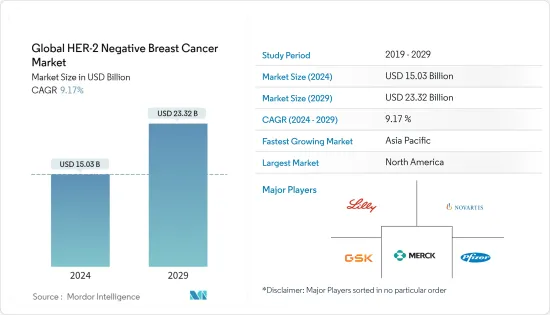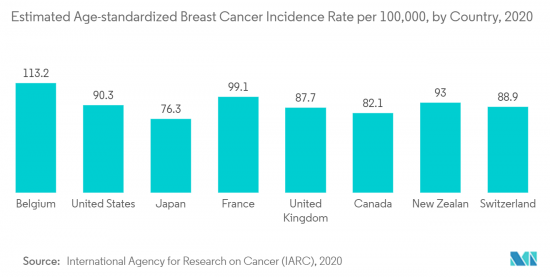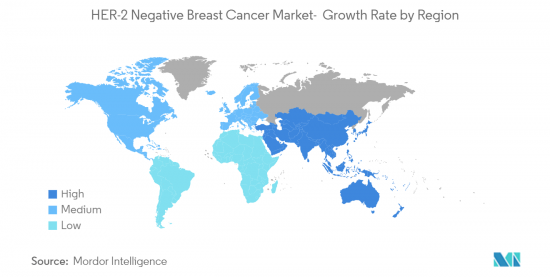
|
市場調査レポート
商品コード
1430589
世界のHER-2陰性乳がん市場:市場シェア分析、産業動向と統計、成長予測(2024年~2029年)Global HER-2 Negative Breast Cancer - Market Share Analysis, Industry Trends & Statistics, Growth Forecasts (2024 - 2029) |
||||||
カスタマイズ可能
適宜更新あり
|
|||||||
| 世界のHER-2陰性乳がん市場:市場シェア分析、産業動向と統計、成長予測(2024年~2029年) |
|
出版日: 2024年02月15日
発行: Mordor Intelligence
ページ情報: 英文 120 Pages
納期: 2~3営業日
|
全表示
- 概要
- 目次
HER-2陰性乳がんの世界市場規模は2024年に150億3,000万米ドルと推計され、2029年には233億2,000万米ドルに達し、推定・予測期間(2024-2029年)のCAGRは9.17%で成長すると予測されます。

COVID-19パンデミックの出現は、世界経済とヘルスケアシステムに悪影響を及ぼしました。世界中が封鎖され、医薬品、医療機器、バイオテクノロジー製品のサプライチェーンに大きな影響を与えました。その一方で、研究開発が注目されるようになり、すべての政府機関やヘルスケアプレーヤーがCOVID-19の診断法や治療法の開発を支援するために名乗りを上げました。例えば、「乳がんの診断と手術におけるCOVID-19パンデミックの影響」と題された研究によると、「乳がんの診断と手術におけるCOVID-19パンデミックの影響」と題されている:2021年12月にJournal of Breast Cancer誌に発表された「A Multi-Institutional Study」によると、COVID-19パンデミックの開始時には、HER-2陽性やHER-2陰性を含む進行性・侵襲性の乳がん患者が増加していました。韓国では、2020年までに乳がんの診断数が9.9%減少しました。積極的な検診プログラムを含むほとんどの日常的な予防行動は減少しています。さらに、乳がん検診は89.2%減少しています。したがって、診断数の減少により需要が大幅に減少している乳がん治療薬メーカーにはマイナスの影響が予想されます。そのため、COVID-19感染を伴うHER-2陰性がんに使用される化学療法が制限され、市場の成長を妨げています。しかし、HER-2陰性がんの治療に使用される特定の治療薬の利用は増加しています。COVID-19は、市場成長には目に見えてマイナスの影響を与えていますが、予測期間を通じて世界のHER-2陰性乳がん市場の成長率をわずかに遅らせています。
さらに、罹患率と有病率はライフスタイルの変化により急速に増加しており、年齢上昇、肥満、アルコールの有害な使用、乳がんの家族歴、放射線被曝歴、生殖歴(月経開始年齢や初回妊娠年齢など)、タバコの使用、閉経後のホルモン療法など、特定の要因が乳がんリスクを高めています。例えば、2022年3月に発表された米国国立衛生研究所のデータによると、HER-2陰性がんは米国全体の乳がん症例の約15~20%を占めています。2022年には、新たに287,850例の女性乳がんが診断されると予測されています。
さらに、Globocan(Global Cancer Observatory)の2020年の報告書によると、乳がんは2020年に世界で最も罹患率の高いがんでした。2020年には約226万1,419人が新たに乳がんと診断されました。乳がん症例の発生率は、2020年の2,261,419例から2040年には3,025,471例に増加すると予測されています。このデータは、世界中で乳がんの負担が増加していることを示しています。したがって、世界中で乳がんの有病率が増加していることから、HER-2陰性乳がん市場は本調査の予測期間中に成長すると予想されます。
HER-2陽性乳がんに対する先進的な標的治療薬の多くがFDAによって承認されています。例えば、2022年8月、FDA(米国食品医薬品局)は、切除不能(切除不能)または転移性(体の他の部位への転移)のHER2乳がん患者の治療のための点滴静注薬Enhertu(fam-trastuzumab-deruxtecan-nxki)を承認しました。
加えて、臨床活動の活発化が市場の成長を支えると思われます。例えば、2022年3月に更新されたClinicalTrials.govによると、ZB716はHER2陰性の局所進行性または転移性乳がん患者を対象に、単剤療法およびパルボシクリブとの併用療法として第II相開発中であり、完了予定は2024年です。このことは、研究対象である市場に成長の展望を開くものと思われます。
しかし、治療費が高く、代替治療が利用可能であることが、この市場の成長を制限すると予想されます。
HER-2陰性乳がん市場の動向
化学療法はHER-2陰性乳がん市場で最も有利なセグメントとして認識
化学療法は最も一般的で積極的な薬物療法のひとつであり、体内のがん細胞を破壊し、それ以上の分裂や増殖を阻止するために用いられます。化学療法薬は全身治療薬であり、薬剤は血流にのって体中のがん細胞にダメージを与え、がん細胞に高い影響を与えます。HER-2陰性乳がんの治療には、過去の治療歴や副作用のリスクなどの条件に応じて、さまざまな種類の化学療法薬が併用または単独で使用されます。
HER-2陰性乳がんの負担の増加、化学療法薬の入手可能性、この領域で進行中の研究開発活動は、化学療法分野の成長を促進する主要因になると予想されます。例えば、2022年2月に発表された「The impact of anthracyclines in intermediate and high-risk HER2-negative early breast cancer-a pooled analysis of the randomized clinical trials PlanB and SUCCESS C」と題された調査研究によると、HER2陰性早期乳がんのほとんどの患者において、ドセタキセル/シクロホスファミド(TC6)6サイクルはアントラサイクリンを含むレジメンと同等の効果があり、全体的なグレード3/4の毒性の発生率がはるかに低いことが判明しました。したがって、このような研究による良好な結果は、化学療法の認知度や採用率を高め、同分野の成長を後押しするものと期待されます。また、上記の情報源によると、HER2陰性の早期乳がんに対する推奨される術後補助療法は、アントラサイクリン/シクロホスファミド-タキサン化学療法(AC-T)である(EBC)。したがって、化学療法の使用は予測期間中に増加すると予想されます。
この領域での研究開発活動の活発化に伴い、市場の主要企業による製品承認やパイプライン製品が増加しており、さらに予測期間中の同セグメントの成長に大きな影響を与えると予想されます。例えば、米国FDAは2021年10月、ホルモン受容体(HR)陽性、HER2陰性で再発リスクが高く、FDA承認検査でKi-67スコアが20%の乳がん成人患者の術後補助療法として、アベマシクリブ(Verzenio)を内分泌療法(アロマターゼ阻害剤またはタモキシフェン)と併用することを承認しました。
このため、新製品の承認と研究開発の継続により、化学療法セグメントは予測期間中に成長すると予測されます。

北米は予測期間中、同様の動向で市場において大きなシェアを占めると予想される
北米は、より優れたヘルスケアインフラ、バイオ医薬品メーカーを支援する財団や独立系ベンチャーグループの増加により、世界のHER-2陰性乳がん市場で大きなシェアを占めると予想されます。
さまざまな州にわたって重要なメーカーが存在し、さまざまなベンチャーパートナーから資金を得ていることが、HER-2陰性乳がん関連市場を牽引しています。例えば、経済協力開発機構(OECD)が発表したデータによると、2022年6月、米国のヘルスケア支出は2021年の国内総生産(GDP)総額の17.8%を占めました。
さらに、メディケア&メディケイド・サービスセンターが2022年3月に発表したデータ「CMS Office of the Actuary Releases 2021-2030 Projections of National Health Expenditures」によると、2021年から2030年にかけての国民医療費の年間平均成長率は5.1%になると予想されています。したがって、医療支出の増加は、国民の間でHER-2陰性乳がん症例を治療するための技術的に高度な治療法やシステムの利用可能性を高め、それによって市場の成長を促進すると予想されます。
一方、製品の上市や開発が増加していることも、地域の成長をさらに後押ししています。例えば、2021年10月、食品医薬品局は、ヒト上皮成長因子受容体2(HER2)陰性の早期乳がん成人患者の術後補助療法として、内分泌療法(タモキシフェンまたはアロマターゼ阻害剤)と併用するCDK 4/6阻害剤であるイーライリリーのVerzenio(アベマシクリブ)を承認しました。また、2021年4月、食品医薬品局(FDA)はサシツズマブ・ゴビテカン(トロデルビー)をトリプルネガティブ乳がん(TNBC)の一部の患者に対して通常の承認を与えました。
さらに、HER-2陰性乳がんの症例数が増加していることも、地域の成長を後押ししています。例えば、breastcancer.orgによる2022年1月の最新情報によると、国内の女性の約8人に1人(約13%)が一生の間に浸潤性乳がんを発症します。このような乳がんの罹患率の高さは、市場成長に役立つ治療オプションの使用に好影響を与えると思われます。Breastcancer.orgが発表した2022年の統計によると、米国では2022年に287,850例の浸潤性乳がんと51,400例の非浸潤性(in situ)乳がんが新たに診断されると推定されています。このように、乳がんの有病率の上昇に起因して、治療オプションの使用が増加しており、予測期間中の市場成長を後押しすると予測されています。
したがって、前述の要因により、調査対象市場は予測期間中に成長すると予想されます。

HER-2陰性乳がん産業の概要
HER-2陰性乳がん市場は、既存の薬物療法の耐性を克服し、標的疾患治療を促進する併用療法を開発することに主眼を置いています。これは、市場参入企業間の提携や協力関係を通じて行われています。このセグメントの主要企業には、 AstraZeneca、Bristol-Myers Squibb Company (Celgene Corporation)、Eli Lilly and Company、 GSK plc.、 Merck & Co. ,Inc.、 Novartis AG、Pfizer Inc.などがあります。
その他の特典:
- エクセル形式の市場予測(ME)シート
- 3ヶ月間のアナリストサポート
目次
第1章 イントロダクション
- 調査の前提条件と市場定義
- 調査範囲
第2章 調査手法
第3章 エグゼクティブサマリー
第4章 市場力学
- 市場概要
- 市場促進要因
- 乳がんの負担増
- 乳がん治療における医療の進歩
- 市場抑制要因
- 頭蓋内ステントを使用する手術の熟練した専門家の不足
- 頭蓋内ステント留置術に関連する脳血管合併症
- ポーターのファイブフォース分析
- 新規参入業者の脅威
- 買い手/消費者の交渉力
- 供給企業の交渉力
- 代替品の脅威
- 競争企業間の敵対関係の強さ
第5章 市場セグメンテーション
- 治療タイプ別
- 化学療法
- 放射線療法
- ホルモン療法
- その他
- 地域別
- 北米
- 米国
- カナダ
- メキシコ
- 欧州
- ドイツ
- 英国
- フランス
- イタリア
- スペイン
- その他欧州
- アジア太平洋
- 中国
- 日本
- インド
- オーストラリア
- 韓国
- その他アジア太平洋地域
- 中東・アフリカ
- GCC
- 南アフリカ
- その他中東とアフリカ
- 南米
- ブラジル
- アルゼンチン
- その他南米
- 北米
第6章 競合情勢
- 企業プロファイル
- AstraZeneca PLC
- Bristol Myers Squibb Company(Celgene Corporation)
- Eli Lilly and Company
- GlasxoSmithKline
- Merck & Co., Inc.
- Novartis AG
- Pfizer
第7章 市場機会と今後の動向
The Global HER-2 Negative Breast Cancer Market size is estimated at USD 15.03 billion in 2024, and is expected to reach USD 23.32 billion by 2029, growing at a CAGR of 9.17% during the forecast period (2024-2029).

The emergence of the COVID-19 pandemic had an adverse effect on the world economy and healthcare system. The lockdown all over the globe has affected the supply chain of pharmaceuticals, medical devices, and biotechnological products largely. On the other hand, research and development have come into focus and all the government agencies and healthcare players come forward to support the development of diagnostics and treatment methods for COVID-19. For instance, according to the study titled 'Impact of the COVID-19 Pandemic on the Diagnosis and Surgery of Breast Cancer: A Multi-Institutional Study' published in the Journal of Breast Cancer in December 2021, at the start of the COVID-19 pandemic, more patients had advanced and aggressive kinds of breast cancer, including HER-2 positive and HER-2 negative disease. In South Korea, the number of breast cancer diagnoses decreased by 9.9% by 2020. Most routine preventative actions, including active screening programs, have been decreased. Furthermore, breast cancer screening has dropped by 89.2%. Thus, this is expected to negatively impact breast cancer drug manufacturers, as their demand has reduced significantly due to the decline in diagnosis. Thus, restricting the chemotherapy used in HER-2 negative cancer with covid-19 infection, hampered the market growth. However, the utilization of specific therapeutic medicines used in the treatment of HER-2-negative cancer has increased. COVID-19 has had sightly negative impact on market growth, while it has slightly delayed the rate of growth of the global HER-2 negative breast cancer market throughout the forecast period.
Furthermore, the incidence and prevalence are growing rapidly due to lifestyle changes and certain factors increase the risk of breast cancer including increasing age, obesity, harmful use of alcohol, family history of breast cancer, history of radiation exposure, reproductive history (such as age that menstrual periods began and age at first pregnancy), tobacco use and postmenopausal hormone therapy. For instance, according to the National Institutes of Health data published in March 2022, HER-2 Negative cancer accounted for around 15-20% of the total breast cancer cases across the United States. It is anticipated that 287,850 new cases of female breast cancer would be diagnosed in 2022.
Additionally, as per the 2020 report of the Global Cancer Observatory (Globocan), breast cancer was the most prevalent form of cancer worldwide in 2020. About 2,261,419 new cases of breast cancer were diagnosed in 2020. The incidence of breast cancer cases is expected to increase from 2,261,419 in 2020 to 3,025,471 new cases by 2040. This data shows an increasing burden of breast cancer worldwide. Therefore, due to the increasing prevalence of breast cancer around the world, the HER-2-negative breast cancer market is expected to grow over the forecast period of the study.
A number of advanced targeted medicines for HER2-positive breast cancer are approved by the FDA. For instance, in August 2022, the Food and Drug Administration (FDA) approved Enhertu (fam-trastuzumab-deruxtecan-nxki), an IV infusion for the treatment of patients with unresectable (unable to be removed) or metastatic (spread to other regions of the body) HER2-breast cancer.
Additionally, rising clinical activity is likely to support the market growth. For instance, according to the ClinicalTrials.gov, updates in March 2022, ZB716 is in phase II development as monotherapy and in combination with palbociclib in patients with HER2-negative locally advanced or metastatic breast cancer, with a completion date of 2024. This is likely to opens up the growth horizons to the market studied.
However, the high cost of treatment and availability of alternative treatments are expected to restrict the growth of this market.
HER- 2 Negative Breast Cancer Market Trends
Chemotherapy Is Identified as the Most Lucrative Segment of HER-2 Negative Breast Cancer Market
Chemotherapy is one of the most common and aggressive form of drug therapy that is used to destroy cancerous cell in the body and stops them from further division and growth. Chemotherapy drugs are systemic treatments; the drugs travel through the bloodstream and damage cancer cells throughout the body due to which they have high impact on the cancerous cells. For the treatment of HER2-negative breast cancer, different types of chemotherapy drugs are used, either in combination with others or alone depending upon the past treatments, risk of side effects and other conditions.
The growing burden of HER2-negative breast cancer, availability of chemotherapy drugs and ongoing research and development activities in the area are expected to be major factors, fueling growth in the chemotherapy segments. For instance, according to a research study published in February 2022, titled 'The impact of anthracyclines in intermediate and high-risk HER2-negative early breast cancer-a pooled analysis of the randomized clinical trials PlanB and SUCCESS C', in most patients with HER2-negative early breast cancer, six cycles of docetaxel/cyclophosphamide (TC6) were found to be equally effective to an anthracycline-containing regimen and to have a much lower incidence of overall grade 3/4 toxicities. Hence, positive result from studies like these are further expected to increase the awareness and adoption of the chemotherapy which is expected to boost segment's growth. Also, as per the above-mentioned source, the recommended adjuvant therapy for HER2-negative early breast cancer is anthracycline/cyclophosphamide-taxane chemotherapy (AC-T) (EBC). Hence, the use of chemotherapy is expected to increase over the forecast period.
With the growing research and development activities in the area, the product approval and pipeline products are increasing by the key players in the market, which is further expected ton have a significant impact on the segment's growth over the forecast period. For instance, in October 2021, the United States FDA approved abemaciclib (Verzenio) in combination with endocrine therapy (either an aromatase inhibitor or tamoxifen) for adjuvant treatment of adult patients with hormone receptor (HR)-positive, HER2-negative breast cancer at high risk of recurrence and a Ki-67 score 20%, as determined by an FDA approved test.
Therefore, owing to the new product approvals and ongoing research and development activities, the chemotherapy segment is expected to growth over the forecast period in the studied market.

North America is Expected to Hold a Significant Share in the Market with Similar Trend in the Forecast Period
North America is expected to hold a significant market share in the global HER-2 negative breast cancer market owing to better healthcare infrastructure, and a growing number of foundations and independent venture groups supporting the biopharmaceutical manufacturers.
The presence of significant manufacturers across the different states, and getting funding from various venture partners drive the market related to HER-2 negative breast cancer. For instance, according to the data published by the Organization for Economic Co-operation and Development (OECD), in June 2022, United States healthcare spending was 17.8% of the total gross domestic product (GDP) of the United States in 2021.
Additionally, as per the data published by the Centers for Medicare & Medicaid Services, in March 2022, titled 'CMS Office of the Actuary Releases 2021-2030 Projections of National Health Expenditures', it has been observed that the annual growth in national health spending is expected to be average 5.1% over 2021-2030. Thus, the increasing health spending is expected to increase the availability of technologically advanced therapies and systems to treat HER-2 negative breast cancer cases among the population, thereby propelling the market growth.
While the increasing product launches and developments are further propelling regional growth. For instance, in October 2021, the Food and Drug Administration approved Eli Lilly's Verzenio (abemaciclib), a CDK 4/6 inhibitor, with endocrine therapy (tamoxifen or an aromatase inhibitor) for adjuvant treatment of adult patients with human epidermal growth factor receptor 2 (HER2)-negative early breast cancer. Also, In April 2021, the Food and Drug Administration (FDA) granted regular approval to sacituzumab govitecan (Trodelvy) for some patients with triple-negative breast cancer (TNBC).
Furthermore the increasing cases of HER-2 negative breast cancer is driving the regional growth. For instance, according to the January 2022 update by breastcancer.org, around 1 in 8 women in the country (about 13%) develop invasive breast cancer over their lifetime. These high cases of breast cancer will have a positive impact on the usage of treatment options that help in the market growth. According to the 2022 statistics published by Breastcancer.org, an estimated 287,850 new cases of invasive breast cancer and 51,400 new cases of non-invasive (in situ) breast cancer are expected to be diagnosed in the United States, in 2022. Thus, owing to the rising prevalence of breast cancer, the use of treatment options is increasing which is anticipated to boost the market growth over the forecast period.
Therefore, owing to the aforementioned factors, the studied market is expected to grow over the forecast period.

HER- 2 Negative Breast Cancer Industry Overview
The primary focus among the companies is to develop combination therapies that shall overcome the resistance of existing drug therapies in the market thus boosting the targeted disease treatment. This is done via collaboration and partnerships among the market players. Some major companies in this segment include AstraZeneca, Bristol-Myers Squibb Company (Celgene Corporation), Eli Lilly and Company, GSK plc., Merck & Co., Inc., Novartis AG, and Pfizer Inc.
Additional Benefits:
- The market estimate (ME) sheet in Excel format
- 3 months of analyst support
TABLE OF CONTENTS
1 INTRODUCTION
- 1.1 Study Assumptions and Market Definition
- 1.2 Scope of the Study
2 RESEARCH METHODOLOGY
3 EXECUTIVE SUMMARY
4 MARKET DYNAMICS
- 4.1 Market Overview
- 4.2 Market Drivers
- 4.2.1 Growing Burden of Breast Cancers
- 4.2.2 Medical Advancements by Breast Cancers Treatment
- 4.3 Market Restraints
- 4.3.1 Lack of Skilled Professional for Operating using Intracranial Stents
- 4.3.2 Cerebrovascular Complications Related to Intracranial Stenting
- 4.4 Porter's Five Force Analysis
- 4.4.1 Threat of New Entrants
- 4.4.2 Bargaining Power of Buyers/Consumers
- 4.4.3 Bargaining Power of Suppliers
- 4.4.4 Threat of Substitute Products
- 4.4.5 Intensity of Competitive Rivalry
5 MARKET SEGMENTATION (Market Size by Value - USD million)
- 5.1 By Type of Treatment
- 5.1.1 Chemotherapy
- 5.1.2 Radiation
- 5.1.3 Hormonal Therapy
- 5.1.4 Others
- 5.2 Geography
- 5.2.1 North America
- 5.2.1.1 United States
- 5.2.1.2 Canada
- 5.2.1.3 Mexico
- 5.2.2 Europe
- 5.2.2.1 Germany
- 5.2.2.2 United Kingdom
- 5.2.2.3 France
- 5.2.2.4 Italy
- 5.2.2.5 Spain
- 5.2.2.6 Rest of Europe
- 5.2.3 Asia-Pacific
- 5.2.3.1 China
- 5.2.3.2 Japan
- 5.2.3.3 India
- 5.2.3.4 Australia
- 5.2.3.5 South Korea
- 5.2.3.6 Rest of Asia-Pacific
- 5.2.4 Middle-East and Africa
- 5.2.4.1 GCC
- 5.2.4.2 South Africa
- 5.2.4.3 Rest of Middle-East and Africa
- 5.2.5 South America
- 5.2.5.1 Brazil
- 5.2.5.2 Argentina
- 5.2.5.3 Rest of South America
- 5.2.1 North America
6 COMPETITIVE LANDSCAPE
- 6.1 Company Profiles
- 6.1.1 AstraZeneca PLC
- 6.1.2 Bristol Myers Squibb Company (Celgene Corporation)
- 6.1.3 Eli Lilly and Company
- 6.1.4 GlasxoSmithKline
- 6.1.5 Merck & Co., Inc.
- 6.1.6 Novartis AG
- 6.1.7 Pfizer

